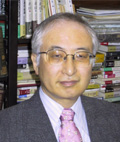Special Session: Japanese Religions and the
Study of Religion
[27 March, Sun., 9:00-12:00]
Buddhism and Modern Nationalism
SUEKI Fumihiko
(University of Tokyo, Japan)
| Outline
One of the characteristics of Buddhist thought in modern Japan
is the attempt to rationalize and demythologize its theory. Specifically,
there is a tendency to be critical of esoteric teachings, to separate
"Buddhist" and "Shinto" elements, to deny the
validity of a Buddhism centered on funerary rites, and to establish
a "contemporary" Buddhism. Such a rationalization of ideas
on the surface (the "upper" structure) does not necessarily
mean that Buddhism as a whole has been modernized. It also means
that there are actual conditions hidden in the shadows (the "lower"
structure) that have become even further concealed. These conditions
include esoteric-magical elements, the mutual complementation of
"Buddhist" and "Shinto" elements, and the management
of the dead through Buddhist funerary rites. In other words, modern
Buddhism has sought to establish its universality through a modern
and rational theoretical framework, but has concealed the faith
of the people as it actually functions in society, and has failed
to deal directly with this theoretical problem. This concealment
is one reason that the relationship of Buddhism to imperial (Tenno)
nationalism has not been sufficiently confronted. |
|
|
| Prof. Susumu Shimazono, President of the JARS Congress
Secretariat of the 19th World Congress of IAHR Department of Religious Studies, Faculty of Letters, University of Tokyo 7-3-1, Hongo, Bunkyo-ku, Tokyo, Japan 113-0033 TEL: (81)3-5841-3765Å@ FAX: (81)3-5841-3888 E-mail address: iahr@l.u-tokyo.ac.jp Congress website: http://www.l.u-tokyo.ac.jp/iahr2005/ |
 SUEKI
Fumihiko studied at the University of Tokyo and received his
Ph. D. degree in 1994. He became Professor in the Graduate School
of Humanities and Sociology at the University of Tokyo in 1995,
where he teaches Buddhism, in particular Japanese Buddhism. He works
mainly on the reconstruction of the intellectual history of Buddhism
in Japan from ancient to modern times. His recent research also
covers Zen philosophy and comparative studies of modern Buddhism.
His publications (in Japanese) include History of Japanese Buddhism
(Tokyo, 1992), Miscellaneous Essays on Japanese Buddhism
(Tokyo, 1993), Studies in Buddhist Doctrines in the Early Heian
Period (Tokyo, 1995), Studies in the Formation of Kamakura
Buddhism (Kyoto, 1998), and Rethinking Modern Japanese Thought
(2004). He has contributed several articles in English to the
Japanese Journal of Religious Studies and other journals.
He was Guest Professor at Ruhr University in Germany in 1997, was
Guest Researcher at Renmin University in China, and Directeur d'Études
Invite de la Section des Sciences Religieuses de l'École
Pratique des Hautes Etudes in 2001.
SUEKI
Fumihiko studied at the University of Tokyo and received his
Ph. D. degree in 1994. He became Professor in the Graduate School
of Humanities and Sociology at the University of Tokyo in 1995,
where he teaches Buddhism, in particular Japanese Buddhism. He works
mainly on the reconstruction of the intellectual history of Buddhism
in Japan from ancient to modern times. His recent research also
covers Zen philosophy and comparative studies of modern Buddhism.
His publications (in Japanese) include History of Japanese Buddhism
(Tokyo, 1992), Miscellaneous Essays on Japanese Buddhism
(Tokyo, 1993), Studies in Buddhist Doctrines in the Early Heian
Period (Tokyo, 1995), Studies in the Formation of Kamakura
Buddhism (Kyoto, 1998), and Rethinking Modern Japanese Thought
(2004). He has contributed several articles in English to the
Japanese Journal of Religious Studies and other journals.
He was Guest Professor at Ruhr University in Germany in 1997, was
Guest Researcher at Renmin University in China, and Directeur d'Études
Invite de la Section des Sciences Religieuses de l'École
Pratique des Hautes Etudes in 2001.